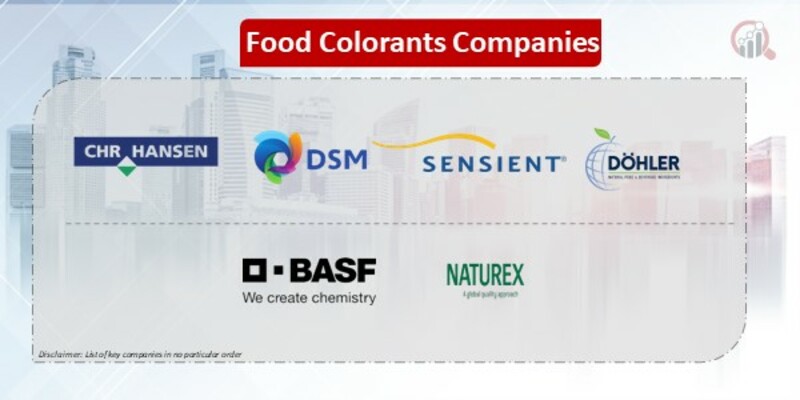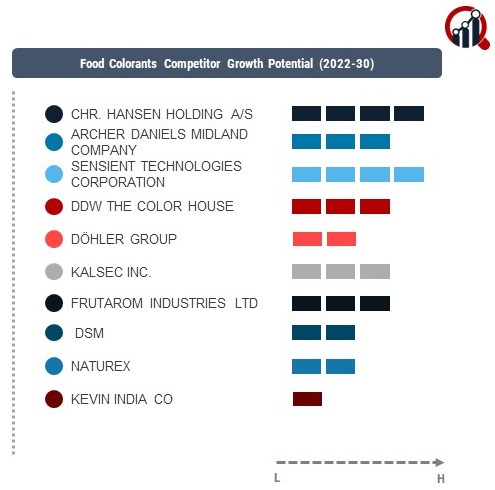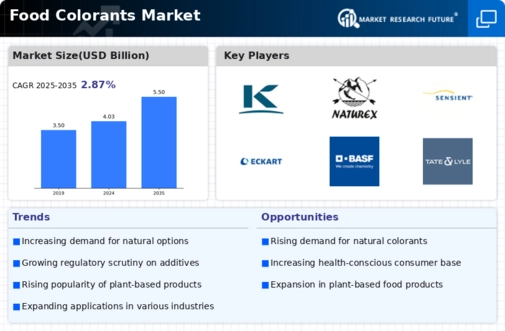Top Industry Leaders in the Food Colorants Market

Strategies Adopted by Food Colorants Key Players
The Food Colorants market is a dynamic and competitive sector driven by consumer preferences, regulatory considerations, and technological advancements. This analysis delves into the key players, strategies, market share factors, news and emerging companies, industry trends, current investment patterns, the overall competitive scenario,
Key Players:
Chr Hansen holdings
D.D. Williamson & Co.
Koninklijke DSM N.V.
Sensient Technologies Corporation
Dohler Group
Naturex SA
Fiorio Colori S.P.A.
BASF SE
GNT Group
and Likored
The Food Colorants market. Key players focus on innovation in response to the growing demand for natural and clean-label products. Research and development efforts are geared towards discovering new, plant-based colorants that align with consumer preferences for healthier and sustainable options.
Partnerships and collaborations with food and beverage manufacturers strengthen market presence. Companies work closely with clients to develop tailor-made color solutions, aligning with specific product requirements and market trends. Investment in state-of-the-art production facilities and technologies ensures a reliable and efficient supply chain, catering to the diverse needs of the food industry.
Market expansion strategies involve tapping into emerging markets and responding to regional variations in consumer preferences. Companies actively participate in industry events and exhibitions to showcase their latest colorant innovations, fostering connections with potential clients and enhancing brand visibility.
Market Share Analysis:
Several factors influence the market share dynamics of Food Colorants. Product quality, consistency, and safety compliance are paramount, with consumers, manufacturers, and regulators placing a premium on adherence to stringent quality standards. Companies with a reputation for producing colorants that meet regulatory requirements and customer expectations secure a significant market share.
Diversification of product portfolios is a key market share strategy. Offering a wide range of color options, including natural, synthetic, and certified organic colorants, allows companies to cater to the diverse needs of the food and beverage industry. This diversification provides flexibility for manufacturers seeking custom color solutions for various applications.
Strategic alliances with raw material suppliers contribute to market share stability. Ensuring a secure and cost-effective supply of key raw materials, such as fruits, vegetables, and other natural sources used in colorant production, is critical for maintaining competitiveness. Companies with well-established supply chain relationships can navigate market fluctuations more effectively.
News & Emerging Companies:
Industry news often revolves around breakthroughs in natural colorant extraction techniques, regulatory updates, and collaborations with food manufacturers. Emerging companies in the Food Colorants market typically focus on developing innovative extraction methods, investing in sustainable sourcing practices, and introducing novel color options.
News regarding mergers and acquisitions is common in the industry as larger companies seek to expand their product portfolios and market reach. Collaborations with research institutions and universities contribute to industry knowledge, helping companies stay ahead in the competitive landscape.
Industry Trends:
The Food Colorants market reflect a commitment to sustainability, clean labeling, and technological advancements. Companies invest in research to develop stable and vibrant color solutions using natural sources, addressing the growing demand for clean-label products. Investments in extraction technologies, such as supercritical fluid extraction and enzymatic processes, aim to enhance efficiency and reduce environmental impact.
Sustainability efforts include responsible sourcing practices, reducing water and energy consumption in production, and adopting eco-friendly packaging solutions. Investments in digital marketing and e-commerce capabilities are also notable trends, reflecting the industry's response to changing consumer shopping behaviors and preferences.
Market expansion efforts involve entering untapped regions, with a particular focus on emerging markets where the demand for processed and packaged foods is on the rise. Companies are also investing in certifications and labeling initiatives to enhance transparency and communicate their commitment to quality and safety.
Competitive Scenario:
The Food Colorants market presents a competitive scenario shaped by a balance between established players and innovative entrants. Market leaders leverage their global presence, research capabilities, and longstanding relationships with manufacturers to maintain dominance. However, emerging companies contribute to market dynamism by introducing novel color solutions, especially in the natural and organic segments.
The overall competitive scenario reflects the industry's adaptability to changing consumer preferences, regulatory landscapes, and technological advancements. Companies navigate this landscape by combining traditional colorant expertise with a commitment to sustainability and innovation, ensuring they remain at the forefront of the evolving Food Colorants market.
Recent Development
The Food Colorants market was the widespread adoption of a new generation of plant-based colorants by major industry players. This development aligned with the growing consumer demand for natural and clean-label products. Companies invested significantly in research and development to identify and scale up the production of colorants derived from fruits, vegetables, and other botanical sources.
This collective effort within the industry showcased a commitment to reducing reliance on synthetic colorants and embracing more sustainable and consumer-friendly alternatives. The shift toward plant-based color solutions was accompanied by comprehensive marketing campaigns to educate consumers about the benefits of natural colorants, contributing to a broader industry narrative centered around health and environmental consciousness.










